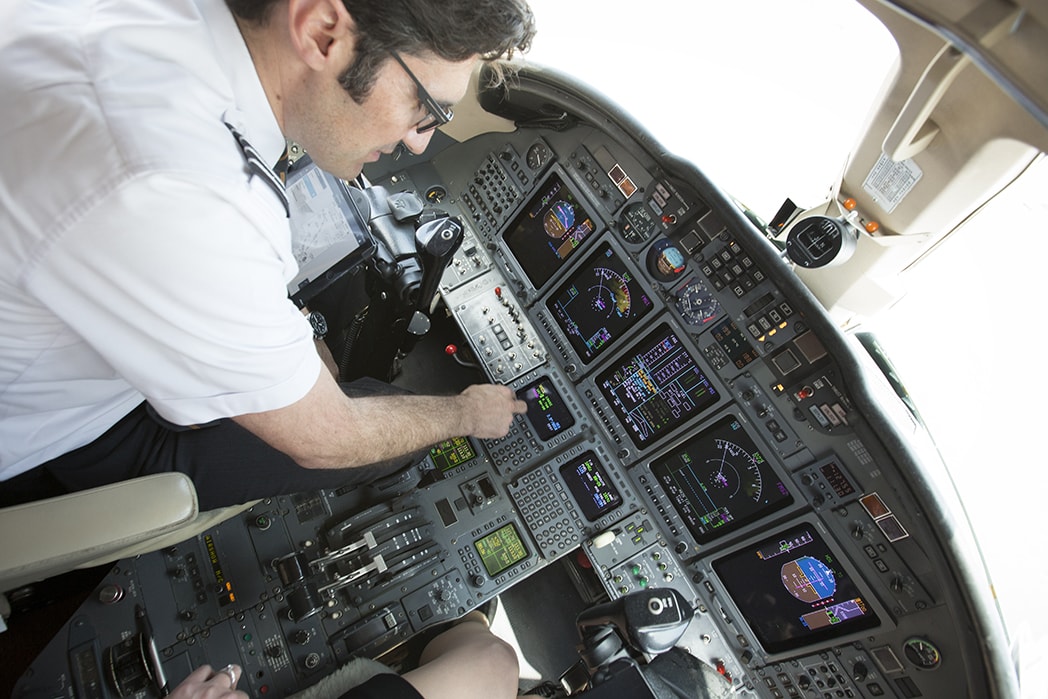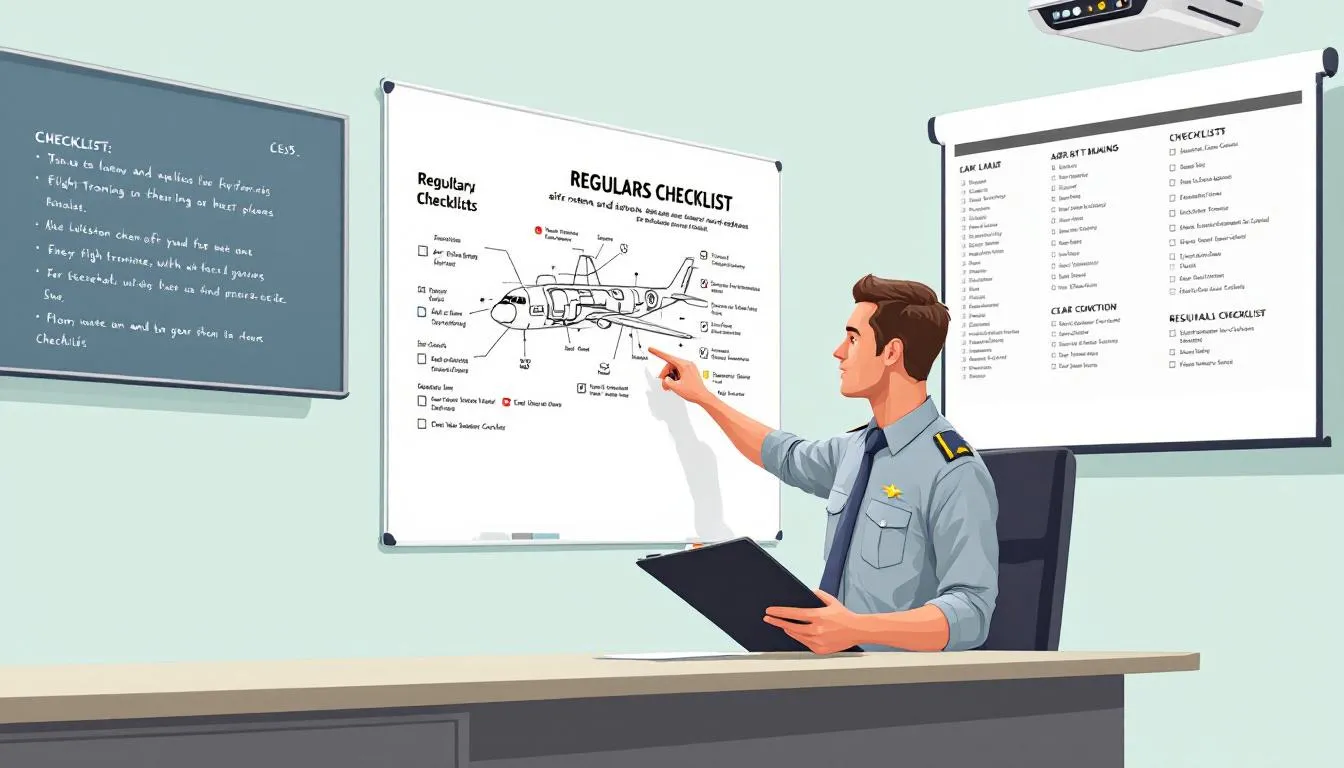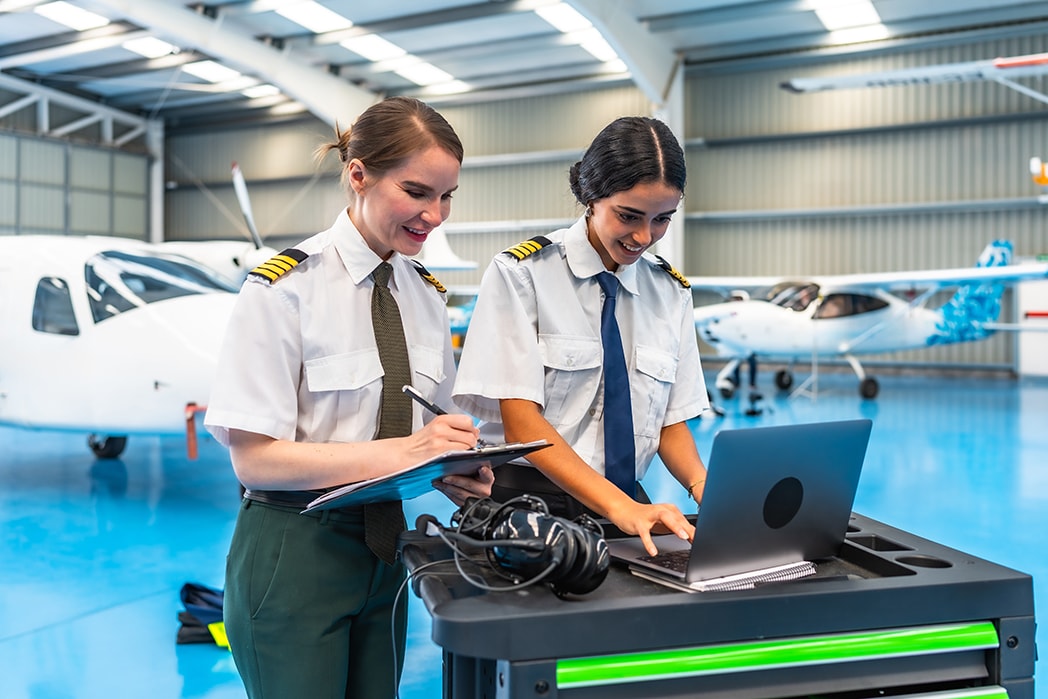CFI Requirements: How to Become a Flight Instructor
Jul 30, 2025
To qualify as a Certified Flight Instructor (CFI), you must hold a commercial pilot certificate with an Airplane Single-Engine Land rating, along with at least 250 hours of flight time.
This article covers all the CFI requirements you’ll need to meet, from eligibility and flight experience to ground training and beyond.
Highlight
-
To become a Certified Flight Instructor (CFI), candidates must meet eligibility requirements including holding a commercial pilot certificate, meeting flight hour benchmarks, and passing necessary knowledge and practical tests.
-
Ground training and aeronautical knowledge are critical elements in preparing for flight instruction, focusing on aviation fundamentals, navigation, and effective teaching techniques.
-
Maintaining CFI certification involves completing renewal requirements every two years, including proficiency checks and participation in Approved Flight Instructor Refresher Courses to stay current with industry standards.
Eligibility Criteria

Before you start your journey to become a Certified Flight Instructor you need to understand the eligibility criteria.
These are the minimum requirements to ensure you have the basic skills and qualifications to teach others to fly. The requirements are:
-
Hold a commercial pilot certificate with an Airplane Single-Engine Land (ASEL) rating. This must be a person's pilot certificate or her pilot certificate as required documentation. Commercial pilots are eligible to apply for a flight instructor certificate.
-
Have at least 250 hours of flight time, or 190 hours if you graduated from a Part 141 school.
-
There is no time requirement to get a flight instructor certificate, so you can focus on meeting the other criteria at your own pace.
Some exemptions from the knowledge test are available for applicants who are employed as teachers at an accredited college or university, or who hold a teacher’s certificate issued by a state authority.
If you are a flight instructor enrolled in a qualification training program at a training center certificated under Part 141 or 142, you may have different requirements.
For ground instructor requirements you must have a ground instructor certificate issued by the FAA.
Eligibility criteria is divided into basic requirements and flight experience. Basic requirements are age, language proficiency and medical certification, while flight experience is specific flight hours and ratings.
These criteria ensure only a qualified pilot who holds a flight instructor certificate and the appropriate certificates and ratings for the instruction they provide can meet the high standards in aviation education.
It is also important to address unsatisfactory training progress during the training process to maintain these standards.
Basic Requirements
You must meet these basic requirements to obtain an applicant's flight instructor certificate, which include holding the appropriate pilot certification, passing knowledge and practical tests, and gaining instructional proficiency. You must be at least 18 years old.
That’s so you have the maturity and responsibility for the job. Proficiency in English is key for effective communication during flight training. A flight instructor's ability to communicate effectively is essential for safe and compliant instruction.
You must be able to read, write and speak English fluently to understand and convey complex instructions and safety procedures.
You must also have a valid FAA 3rd Class Medical Certificate to meet the medical standards for a flight instructor. As part of the application process, you must demonstrate knowledge in key areas such as stall awareness, spins, and spin recovery procedures.
Meeting these basic requirements is the first step to getting your CFI and fulfilling the flight instructor's responsibilities in training and endorsing students.
Flight Experience

Flight experience is a requirement for a flight instructor rating; you must have at least 250 hours of flight time. That’s plenty of time in the air to develop the skills and knowledge to teach others.
You also need at least 15 hours of pilot in command in the relevant category and class of aircraft, including pilot in command time in the flight and aircraft category. The experience must match the requirements for the flight instructor rating you are seeking.
You’ll need to hold either a commercial pilot certificate or an airline transport pilot certificate, along with an instrument rating, to become a Certified Flight Instructor.
These credentials confirm your ability to operate in complex flight environments and train others effectively.
Many pilots fulfill the instrument rating requirement by completing structured IFR courses, which prepare them for safe and precise flight in instrument meteorological conditions.
It shows you have a thorough understanding of flight instruments, navigation and other aspects of flying, including your flight instructor rating and airline transport pilot certificates. The applicant must have the ratings for the flight instructor rating being sought.
For initial flight instructor applicants it’s important to meet these flight experience requirements so you are well prepared for the challenges of teaching.
Providing flight training requires technical proficiency and the flight instructor’s ability to guide students through flight preparation, solo cross country flight and other training activities, including a flight instructor’s guidance.
The instructor must demonstrate instructional proficiency in stall awareness, spin entry, spins and spin recovery procedures. Understanding flight instructor responsibilities is key to teaching.
As an instructor you are responsible for overseeing the student’s flight preparation and ensuring they are ready for each phase of training.
You must also ensure all requirements for granting solo flight privileges are met, including verifying the student has all solo flight privileges required, verifying the student has a valid student pilot certificate and providing proper endorsements in the student pilot’s logbook for solo flights, cross country flights and specific airspace operations.
Your flight simulator experience is the foundation of your instructional ability to mentor student pilots.
Ground Training

Ground training is important for flight instructors, it gives you the knowledge and skills to be a good teacher. As a CFI you will be teaching both theoretical and practical knowledge to your students.
Enhanced qualification training programs are available for advanced instructor preparation, with ground and flight training components to cover emergency procedures, safety evaluation and scenario based instruction.
Ground training gives you the foundation knowledge in aeronautical subjects like aviation fundamentals, navigation and meteorology, including log ground training and ground or flight training.
Participating in a qualification training program which is an approved and structured course under part 141 or 142 can also fulfill ground training requirements and further develop your skills in risk management and teaching methods.
This section covers the requirements for a ground instructor certificate and the aeronautical knowledge areas CFI candidates must know.
Ground instructor certificate is a must have for any flight instructor so you will be well prepared to teach and guide your students.
Ground Instructor Certificate
To get a ground instructor certificate you must:
-
Complete training
-
Show knowledge of aeronautical subjects
-
Pass a written exam on aviation fundamentals
A ground instructor certificate issued by the FAA is required for eligibility.
This certificate is a stepping stone to a flight instructor certificate and provides the foundation for teaching.
It also helps prepare you for obtaining an appropriate flight instructor certificate, which ensures you are properly qualified to teach in both ground and flight environments.
The ground instructor certificate gives you the theoretical knowledge to go with your flight training.
It means you are knowledgeable in many aeronautical subjects and can instruct your students comprehensively. This certificate is the foundation of aviation education.
Aeronautical Knowledge Areas
CFI’s must know subjects like aircraft systems, navigation and meteorology. These subjects are key to understanding flight principles and safe and efficient flight operations. Topics include:
-
Aerodynamics
-
Regulations
-
Navigation
-
Weather
-
Aircraft performance
The oral part of the practical test will test the instructor’s knowledge of these aeronautical subjects and regulations. Questions may cover regulations, flight maneuvers and instructional techniques so candidates are well prepared to teach these subjects.
Knowing these aeronautical knowledge areas means you can teach ground and flight training to your students. This theoretical foundation is the key to being an effective and knowledgeable flight instructor.
Flight Training

Flight training is key to being a proficient pilot and involves a structured learning environment, with flight training that includes:
-
Flight maneuvers
-
Safety protocols
-
Emergency procedures
As a flight instructor you will be teaching these to your students. Certain maneuvers and proficiency checks can be conducted using an approved flight training device that meets FAA standards.
Equipping students with the right tools including essential USAF gear such as helmets, flight suits, and communication equipment ensures both safety and realism during hands-on training.
This section covers two important parts of flight training: stall awareness and spin entry, and practical proficiency in stall awareness spin entry.
Stall awareness and spin entry training is critical to understanding and recovering from spin incidents, and you must demonstrate instructional proficiency so you can teach maneuvers and correct common flight errors.
At the end of your training, you must pass the required practical test, which assesses your ability to perform and teach these essential skills.
Stall Awareness and Spin Entry
Spins occur from asymmetrical stalls where one wing stalls deeper than the other and you go corkscrewing down. Understanding spin dynamics is key to safe flying as spins can be entered from almost any attitude and airspeed.
Spin entry training involves practicing how to enter a spin safely and how to recover, including entry spins and spin.
Awareness spin entry spins are a vital component of this training, helping instructors and students build confidence in recognizing, entering, and recovering from spins under controlled conditions.
Effective spin recovery procedures are critical to getting control of the aircraft back after a spin.
As a flight instructor you need to be proficient in stall awareness and spins and spin recovery instructional procedures so you can teach these critical recovery procedures to your students.
Demonstrating instructional proficiency in stall awareness, spin entry, spins, and spin recovery is essential for both flight instructor candidates and certified instructors, as it ensures the ability to effectively teach these maneuvers.
This training ensures you and your students are prepared for any abnormal and emergency procedures related to spin related emergencies.
Practical Instructional Proficiency
You will demonstrate your instructional abilities through practical tests of various flight maneuvers. This includes:
-
Analyzing and correcting common flight errors to show instructional proficiency.
-
Instructing on different flight maneuvers during practical tests.
-
Showing instructional proficiency.
-
Obtaining a logbook endorsement from an authorized instructor indicating proficiency in the required training areas.
A successful flight instructor not only demonstrates knowledge but also possesses instructional proficiency, enabling them to teach effectively, adapt to student needs, and promote safe aviation practices.
Assessing instructional proficiency, which has instructional proficiency, is key to becoming a flight instructor.
It means you can give good flight instruction, guide your students through training and help them develop the skills to fly safely and efficiently.
Knowledge Tests

You will also need to pass specific knowledge tests in addition to practical tests to be ready for flight instruction duties.
These tests cover all aspects of aviation to make sure you have a broad understanding of the subjects you will be teaching.
One of the knowledge tests required for flight instructor certification is the required knowledge test, the FAA Flight Instructor Airplane (FIA) Knowledge Test. If you are required to retake a knowledge test, results from a previous test may be accepted, unless the retest is due to deficiencies that require re-evaluation in specific instructional areas.
This section covers two knowledge tests: Fundamentals of Instructing (FOI) and Flight Instructor Airplane (FIA) tests.
These tests will evaluate your knowledge of instructional techniques, learning principles and critical aviation concepts so you can teach your students.
Fundamentals of Instructing (FOI)
To begin your journey toward becoming a flight instructor, you’ll need to pass the FAA Fundamentals of Instructing (FOI) Knowledge Test.
This test covers teaching strategies, student evaluation and lesson planning. It tests your understanding of instructional techniques and learning principles.
You must score at least 70% on the FOI test. This test ensures you have the basic knowledge to be a good flight instructor and to guide and evaluate your students.
Flight Instructor Airplane (FIA)
The FIA test covers many subjects important for being a flight instructor including commercial pilot concepts. The topics in the FIA test measure your understanding of things relevant to flight instruction including regulations and procedures.
The subjects in the FIA test are the critical areas a flight instructor must know to teach and be safe in flight operations.
You must complete the FIA test within the time allowed and pass to continue in the certification process. This test ensures you have the knowledge to be a flight instructor.
The Practical Test

The test is an overall evaluation of both oral and flight skills according to the Practical Test Standards (PTS). It’s two parts: the oral and the flight.
You need several endorsements from your instructor before you can take the test to make sure you’ve met all the requirements. Upon passing you’ll get flight instructor certificates which are subject to specific regulations and limitations.
This section covers the ground and flight portion of the test, what to expect and how to prepare.
During the test the examiner will be evaluating the flight instructor’s ability to teach, perform the required maneuvers and ensure you can pass on knowledge and skills according to FAA regulations. Knowing the structure and content of the test is key to passing.
Ground Portion
The CFI oral exam usually takes 4-5 hours so it’s a big test of your knowledge and preparation. During this ground portion the examiner will be testing your understanding of various aviation concepts, regulations and instructional techniques.
Questions will cover a wide range of topics such as aeronautical knowledge, flight regulations and teaching strategies.
This segment is to make sure you have the overall knowledge to teach students. Thorough preparation including reviewing key subjects and understanding the structure of the oral exam is key to passing this part of the practical test.
Flight Portion
The flight portion of the practical test will test your ability to teach and demonstrate various maneuvers.
Common maneuvers tested are taxiing, takeoffs, landings, straight and level flight, turns, climbs, descents, maneuvers, stalls and emergency procedures. The test must be conducted in an aircraft appropriate to the flight instructor rating sought.
During this portion the DPE will expect you to use checklists, brief your students, make aeronautical decisions, maintain sterile cockpit procedures and positive exchange of controls.
Candidates will be tested with unexpected challenges by the Designated Pilot Examiner to see how you handle real world scenarios.
Show your flying and instructional skills during the flight portion and you’ll get your flight instructor certificate. The FAA may impose such operating limitations on your certificate if necessary.
Summary
Becoming a Certified Flight Instructor is a journey that requires dedication, knowledge and passion for teaching.
From meeting the eligibility criteria and getting flight experience to mastering ground training and passing knowledge tests, each step is designed to make you ready to teach the next generation of pilots.
The practical test, both oral and flight, will evaluate your ability to apply what you know and your certification will keep you current with industry standards.
In summary, becoming a CFI is tough but very rewarding. Follow the steps in this guide and you’ll navigate the certification process with confidence and become a skilled and knowledgeable flight instructor.
Enjoy the journey, keep learning and inspire the future aviators who will look up to you as their mentor.
